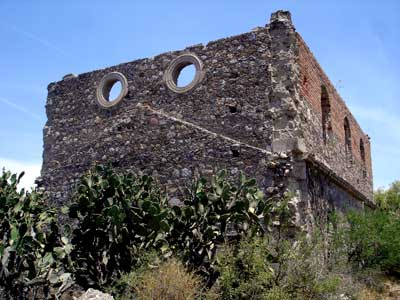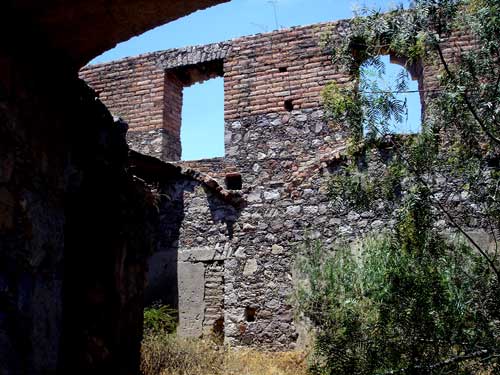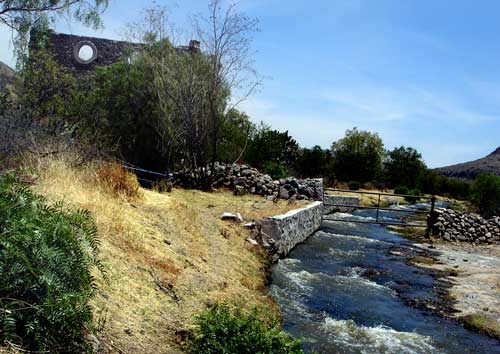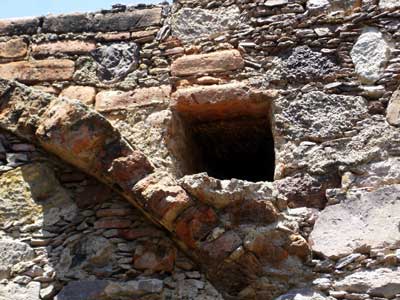My Encounter with Africanized Bees
By Maria Cristina Barragán Salin
Africanized Bees Kill Three Horses and a Dog
[We warmly thank María Cristina Barragán for contributing this detailed
account of an attack by Africanized bees in Mexico. Every story helps us better
understand how to prevent or deal with these life-threatening situations.
–Editor]
Summer, 2008
Location of Attack: Rancho La Troje, Lagos de Moreno, Jalisco, Mexico
 First of all, it is important to mention that I was a beekeeper some 20 years
ago. I had an apiary and learned how to manage bees and obtain honey. This
experience helped me understand their behavior in the hive and how to get along
with them peacefully. I am not afraid of bees, even after the attack—but I am
now much more cautious.
First of all, it is important to mention that I was a beekeeper some 20 years
ago. I had an apiary and learned how to manage bees and obtain honey. This
experience helped me understand their behavior in the hive and how to get along
with them peacefully. I am not afraid of bees, even after the attack—but I am
now much more cautious.
That day we went out for a horseback ride in the pastures of Rancho La Troje. My two daughters (15 and 7 years old)
and I were with a friend and her two girls
(15 and 9), as well as two cowhands who accompanied us. Along the way, we came
to the ruins of two flour mills where, as children, we used to enjoy climbing to
the upper floors to take photos.
At about 1:00 in the afternoon, we dismounted and securely tied our horses at
the entrance to the mills, so the girls could explore them and take pictures.
The cowhands had gone off to hunt for some cows which had gotten lost in the
area. The two teenagers climbed the remains of an old inner wall in order to
reach the windows of the upper floor, which were about four meters above the
ground.
|
At that moment, I noticed that below the windows there was a swarm of
bees—apparently not very large—in a hole in the wall. Calmly, I told the
children to quickly finish taking pictures so we could leave without bothering
the bees. I said these words in a clear voice but without shouting.
The square hole
can be seen just below the left window. Photo by Cristina Barragán.
|
 |
At that very
instant, the attack began. The bees came at the teens up above and at the rest
of us down below. Instantly, the heads and bodies of the teens were covered with
bees. They were both screaming in desperation. I told my friend to take the
small ones as far away as possible while I tried to help the teens who were
already at the point of wanting to throw themselves out of the windows. With
great difficulty, they were able to climb down, but it was horrible: the bees
were stinging us everywhere, in our eyes, ears, face, neck and arms. We couldn’t
get them off of us for anything!
|
Suddenly, it occurred to my daughter to shout, “Jump in the water!” and we ran
over to an irrigation canal a few meters away, which, by chance, had water
running through it at that moment. It was a meter wide and no more than 60
centimeters deep. Into this ditch we threw ourselves and that was how we managed
to free ourselves of the bees.
The irrigation canal, photographed at a later
date, holding more water than on the day of the attack.
Photo by Cristina Barragán.
|
 |
While all this was happening to us, we realized that the bees had simultaneously
attacked the horses which were desperately trying to free themselves from the
ropes with which we had tied them. I shouted for help to the cowboys who came on
the run and immediately went to help the horses. By then, some of the horses had
managed to get loose by themselves and the others were freed when the cowboys
cut their ropes. All of them ran off, frightened to death.
 |
Afterwards we noticed that those of us who received the most stings were the two
teens, my two schnauzer dogs and I. My friend had only five stings, her
smaller daughter three and my little girl not even one!
Cristina's face, swollen from bee stings. |
Despite the circumstances, I remained calm but I knew we had to return home as
soon as possible because the girls had been badly stung and needed treatment.
And, of course, they were terribly scared.
Unfortunately, we were far from home and could not walk back in the hot sun
because this would accelerate the effect of the poison. However, I was able to
ask for help by cell phone because my daughter had had the presence of mind to
take her phone out of her pocket before jumping into the water.
A pickup truck was sent to rescue us and we set out to meet it, wanting to get
as far away as possible from the mills. We walked slowly, to avoid accelerating
the circulation of poison in our bodies. We went about 800 meters at which point
we saw our rescuers. Just when the pickup arrived, one of the vaqueros told me
the bees were still attacking the horses en masse and they could find no way to
stop them. So I gave him a box of matches belonging to the driver of the pickup
and told him to start a fire, as the only thing that will drive off bees is
smoke.
At last we reached home and immediately took baths (water relieves the burn of
the bee stings). I gave everyone, even the dogs, Avapena as an antihistamine and
Febrax to alleviate the pain and swelling.
When everyone had more or less calmed down, I returned to the pasture to see if
the cowhands needed help. This was about two hours after the attack. At the
pasture, I met them on their way back and they told me that two of the horses
had died. I couldn’t believe it! We immediately went to care for the other
horses, which had also been badly stung, in particular two mares. At the
recommendation of a veterinarian, we injected them with an antihistamine for
animals.
We passed an awful night, wrestling with the situation of the teenagers, who had
fevers and were vomiting. Even the dogs were overwhelmed by this. We kept up the
treatments of Avapena and Febrax (see comment below—Editor).
|
The next day we all felt more normal and decided to return to Guadalajara. That
evening we learned that another horse—one of the mares—was dead. The following
morning one of my dogs also died.
Close up of the
opening where the hive had been located.
|
 |
We brought the whole matter to the attention of Protección Civil in the
municipality of Lagos de Moreno. Days later, they showed up and removed the
hive.
María Cristina Barragán Salin
April, 2009
Comments
It is most useful to know that submersion in water saved these people from
further attack. Some sources have claimed that bees simply wait for their
victims to surface and then resume the onslaught. Obviously, this did not happen
at Rancho La Troje.
The manufacturers of Avapena recommend that badly stung people should take one
pill and go directly to a hospital for further treatment. –John Pint

Cristina's family at Rancho
La Troje, under happier circumstances
Este artículo
en español
More on Mexico's Africanized Bees
HOME
 First of all, it is important to mention that I was a beekeeper some 20 years
ago. I had an apiary and learned how to manage bees and obtain honey. This
experience helped me understand their behavior in the hive and how to get along
with them peacefully. I am not afraid of bees, even after the attack—but I am
now much more cautious.
First of all, it is important to mention that I was a beekeeper some 20 years
ago. I had an apiary and learned how to manage bees and obtain honey. This
experience helped me understand their behavior in the hive and how to get along
with them peacefully. I am not afraid of bees, even after the attack—but I am
now much more cautious.



